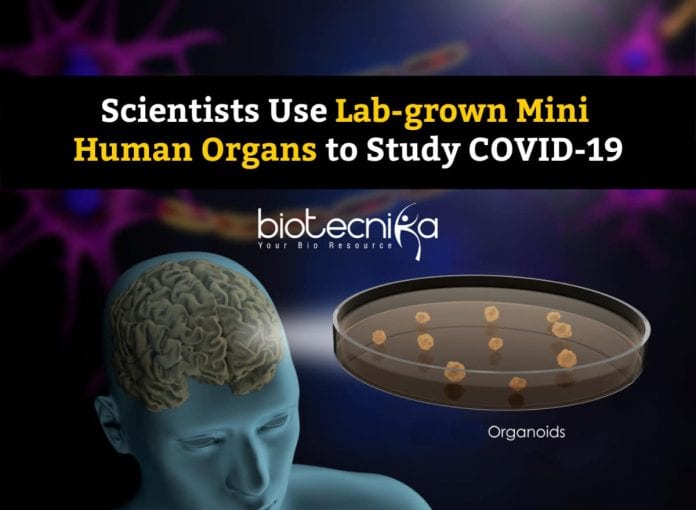Studying COVID19 Using Organoids – Lab-grown Mini Human Organs
Leading scientists say that research on the novel coronavirus can be accelerated and can pave ways for new COVID-19 therapies by an emerging technique that uses lab-grown tiny human organs to study viral diseases.
The Director of Life Science Institute at the University of British Columbia (UBC) in Canada, Josef Penninger says, “The lab-grown organs, organoids, closely resemble human tissues that are relevant for disease.”
Penninger said that to test vaccines and drugs against COVID-19 and to explore how the SARS-CoV-2 virus replicates in hosts, scientists are beginning to perform more experiments in these human organ-like structures. These tiny organs contain cells that are also present in a “real” human organ and are cultured from undifferentiated cells in the human body called stem cells.
For instance, perfect mini versions of the vascular tissue are the organoids of blood vessels, made up of empty cavity, a membrane wrapped around and keeping it together, and cells that stabilize it.
Likewise, multiple cell types found in a normal kidney, including the ones acting as an entry gate for SARS-CoV-2, expressing the ACE2 receptor, are present in the kidney organoids.
Organoids to Study COVID-19
In
studying COVID-19 symptoms, research using organoids can open new doors, says Penninger.Previously, to understand how the Zika virus causes intellectual disability in developing newborns, and smaller head size, the tiny organs had helped scientists in their research. A study published in the journal Viruses last year, it was revealed which cells were affected by the Zika virus in the infection of brain organoid models.
A stem cell biologist from Cornell University in the US, Shuibing Chen said, ” Colon cancer cell lines and Vero cell lines which are derived from monkey kidneys are the commonly used lab models for studying infectious diseases, but what actually happens in humans is not fully captured in these.”
Chen said that researchers are studying SARS-CoV-2 infection in mice, but the human version of ACE2 (the SARS-CoV-2 ‘gateway’ receptor) is not the same in rodents.
She said that these limitations can be excluded by using organoids as the way scientists understand and test potential COVID-19 therapeutics can be changed using organoids.
For instance, in a study involving blood vessel and kidney organoids, Penninger and his colleagues found recently that a trial drug could block the early stages of COVID-19.
Around 1,280 drugs already approved by the US Food and Drug Administration against novel coronavirus infection of the intestines were screened in another study, published in the preprint server bioRxiv. To study COVID-19, the scientists who studied these drugs on large intestine organoids said that there is an urgent need to create standard models of these tiny organs.
Chen explained, “There are more than 10 different cell types like nutrient absorbing cells, and cells that produce hormones in the colon. To capture the complexity of the COVID-19 infection, there is a growing number of COVID-19 research using organoids since using just one human cell line over-simplifies studies.”
Chen cites an example of a study showing how SARS-CoV-2 infects intestinal cells, published in the journal Science.
The co-author of this study from the Hubrecht Institute in the Netherlands, Joep Beumer said that the information on which cells in the outer layer of the intestine are infected by the virus, likely contributing to gut-related COVID-19 symptoms like diarrhea are revealed in the organoid experiments.
Previously, a new method to grow snake venom gland cells as organoids were developed by scientists led by Hans Clevers.
Penninger also believes that via organoid studies, many puzzles about COVID-19, such as how it can be blocked from entering the cells, and how the virus lives inside cells can be pieced together.
He said, “The most rationale therapy possible for COVID-19 is probably tricking the virus and preventing it from finding the ACE2 entry gate.”
He added, “Even in tissues like the heart, and especially the lung, many groups in the world are following our example and are developing or using organoids for COVID-19 studies.”
Some Caution Using Organoids
Organoids might not be able to capture the whole reality of diseases, caution some scientists.
At SASTRA School of Chemical & Biotechnology in Tamil Nadu, Professor of microbiology, Saisubramanian N says, “The immune system and the endocrine system are missing in organoids, even though they are certainly better than cell culture.”
Beumer noted that special versions of the tiny organs in which the virus, organoids, and immune cells are co-cultured can be used, in order to overcome this limitation.
Beumer said along with the supply of patient biopsies as a source for the organoid culture, equipment like culture hoods and 37 degrees Celsius incubators are required for growing these mini-organs. Organoids can be grown for years once this infrastructure is developed.
Source
Studying COVID19 Using Organoids, Studying COVID19 Using Organoids































nice,keep updating me